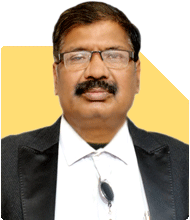Ramalingam Kalirajan |8083 Answers |Ask -Follow
Mutual Funds, Financial Planning Expert - Answered on Jul 12, 2024
He has an MBA in finance from the University of Madras and is a certified financial planner.
He is the director and chief financial planner at Holistic Investment, a Chennai-based firm that offers financial planning and wealth management advice.... more

I am 78 years old and my wife is 75 years old. We have no liabilities. We both are covered by Mediclaim policies. Currently I have a corpus of 1.85 cr.consisting of 63 lakhs in FDs and balance 1.22 crore in MF/ Shares. I am still working and earn around 1.5 lakhs per month. I have on going SIP in MF of Rs.32000.00 per month. I need your opinion on whether I should redeem my mutual fund and share corpus of 1.22 cr.and invest in FDs.
Current Financial Position
At 78, with your wife at 75, you both are in a life stage where preserving capital is paramount. You have Rs 63 lakhs in FDs and Rs 1.22 crore in mutual funds and shares, totalling Rs 1.85 crore. Your monthly SIP of Rs 32,000 in mutual funds also reflects a disciplined investment approach.
Evaluating Fixed Deposits
Fixed deposits are a popular choice for senior citizens because they offer guaranteed returns. However, there are certain aspects to consider:
Interest Rates: FDs provide fixed returns but are subject to prevailing interest rates, which have been relatively low in recent years. This might not keep pace with inflation, affecting your purchasing power.
Safety and Security: FDs are considered safe, but they are not entirely free of risks. If you have amounts exceeding Rs 5 lakh in a single bank, only Rs 5 lakh is insured under the Deposit Insurance and Credit Guarantee Corporation (DICGC).
Tax Implications: Interest earned on FDs is fully taxable as per your income tax slab, which can significantly reduce your net returns.
Assessing Mutual Funds and Shares
Mutual funds and shares offer the potential for higher returns, but with accompanying risks. Let’s look at their advantages and disadvantages:
Potential for Higher Returns: Historically, equity and balanced mutual funds have outperformed FDs over the long term. This can help in beating inflation.
Tax Efficiency: Long-term capital gains on equity mutual funds are taxed at 10% after Rs 1 lakh exemption, which can be more tax-efficient than FD interest.
Liquidity: Mutual funds, especially debt funds, offer better liquidity without penalty, unlike premature withdrawal from FDs.
Market Volatility: The primary risk is market volatility, which can lead to fluctuations in the value of your investments. However, this can be mitigated with a well-diversified portfolio.
Recommended Strategy: Balancing Safety and Growth
Given your age and financial stability, a balanced approach is prudent. Here’s a detailed strategy:
Maintain a Core FD Portfolio
Continue to hold a significant portion in FDs for capital preservation. This ensures safety and a steady income stream. Since you already have Rs 63 lakhs in FDs, it’s wise to maintain this or even slightly increase it.
Diversify Within Mutual Funds
Rather than redeeming your entire mutual fund and share corpus, consider the following:
Shift to Balanced or Hybrid Funds: These funds offer a mix of equity and debt, providing growth potential while managing risk.
Increase Allocation to Debt Funds: Debt funds are less volatile than equity funds and can offer better returns than FDs, along with tax efficiency. They are ideal for regular income with lower risk.
Systematic Withdrawal Plan (SWP): Set up an SWP from your mutual funds to get a regular income. This can be structured to meet your monthly expenses without impacting the principal significantly.
Regular Monitoring and Rebalancing
Regularly review your portfolio with your Certified Financial Planner (CFP). This ensures your investments align with your financial goals and risk tolerance. Rebalancing helps maintain the desired asset allocation.
The Case Against Shifting Entirely to FDs
Moving all your investments to FDs is not advisable for several reasons:
Inflation Risk: Over time, the real value of your savings can erode if FD returns do not outpace inflation. This can impact your purchasing power and financial security.
Lack of Diversification: Concentrating solely on FDs exposes you to reinvestment risk, especially in a low-interest-rate environment.
Opportunity Cost: By moving entirely to FDs, you miss out on the growth potential that equities and mutual funds offer, which can be crucial for maintaining your lifestyle over the long term.
Understanding Actively Managed Funds
Actively managed funds involve professional fund managers who aim to outperform market indices. Here are some key benefits:
Potential for Higher Returns: Fund managers use research and expertise to select stocks that can outperform, providing better returns than passive index funds.
Risk Management: Active funds can adapt to market changes, reducing exposure to underperforming sectors or stocks, thereby managing risk more effectively.
Flexibility: These funds can take advantage of market opportunities and shifts, which is not possible with passive index funds.
Drawbacks of Index Funds
Index funds replicate the market index and provide average market returns. Here are some disadvantages:
No Outperformance: Index funds aim to match market performance, offering no potential for excess returns. This limits growth opportunities.
Market Risk: Index funds are fully exposed to market downturns, with no active management to mitigate losses.
Lack of Flexibility: These funds cannot adjust holdings based on market conditions or economic changes, which can be a disadvantage in volatile markets.
Importance of Investing Through MFD with CFP Credentials
Investing through a Mutual Fund Distributor (MFD) with CFP credentials offers several advantages:
Professional Guidance: MFDs with CFP credentials provide personalized advice based on your financial goals, risk tolerance, and investment horizon.
Regular Reviews: They offer regular portfolio reviews and rebalancing to ensure your investments remain aligned with your objectives.
Expertise and Experience: These professionals have the expertise to navigate market complexities and recommend suitable investment options.
Your proactive approach to financial planning at this stage in life is admirable. Maintaining a disciplined SIP and having a diversified portfolio shows great foresight and diligence.
We understand that managing investments in retirement can be daunting. Ensuring financial security for yourself and your spouse is paramount. Balancing safety and growth requires careful consideration, and we are here to help.
Final Insights
Your financial strategy should focus on preserving capital while ensuring adequate growth to outpace inflation. Maintain a core FD portfolio for safety and diversify within mutual funds to benefit from growth potential. Regular monitoring and rebalancing with a Certified Financial Planner (CFP) will help you achieve financial stability and peace of mind.
Remember, your financial journey is unique. Tailor your investments to suit your specific needs and goals, ensuring a comfortable and secure retirement.
Best Regards,
K. Ramalingam, MBA, CFP,
Chief Financial Planner,
www.holisticinvestment.in
You may like to see similar questions and answers below
Anil Rego |388 Answers |Ask -Follow
Financial Planner - Answered on Apr 07, 2024
Ramalingam Kalirajan |8083 Answers |Ask -Follow
Mutual Funds, Financial Planning Expert - Answered on May 11, 2024
Ramalingam Kalirajan |8083 Answers |Ask -Follow
Mutual Funds, Financial Planning Expert - Answered on Jul 10, 2024
Ramalingam Kalirajan |8083 Answers |Ask -Follow
Mutual Funds, Financial Planning Expert - Answered on Sep 26, 2024
Rajesh Kumar Singh |150 Answers |Ask -Follow
IIT-JEE, GATE Expert - Answered on Mar 06, 2025
Rajesh Kumar Singh |150 Answers |Ask -Follow
IIT-JEE, GATE Expert - Answered on Mar 06, 2025
Rajesh Kumar Singh |150 Answers |Ask -Follow
IIT-JEE, GATE Expert - Answered on Mar 06, 2025
Rajesh Kumar Singh |150 Answers |Ask -Follow
IIT-JEE, GATE Expert - Answered on Mar 06, 2025
Sushil Sukhwani |588 Answers |Ask -Follow
Study Abroad Expert - Answered on Mar 06, 2025
Radheshyam Zanwar |1340 Answers |Ask -Follow
MHT-CET, IIT-JEE, NEET-UG Expert - Answered on Mar 06, 2025
Mayank Chandel |2086 Answers |Ask -Follow
IIT-JEE, NEET-UG, SAT, CLAT, CA, CS Exam Expert - Answered on Mar 06, 2025
Rajesh Kumar Singh |150 Answers |Ask -Follow
IIT-JEE, GATE Expert - Answered on Mar 06, 2025

Radheshyam Zanwar |1340 Answers |Ask -Follow
MHT-CET, IIT-JEE, NEET-UG Expert - Answered on Mar 06, 2025
Rajesh Kumar Singh |150 Answers |Ask -Follow
IIT-JEE, GATE Expert - Answered on Mar 06, 2025























